To reduce noise from vertical axis wind turbines (VAWTs), you can focus on aerodynamic improvements and smart design choices. Optimize blade shapes, incorporate serrated edges, and use low-noise airfoils to minimize turbulent airflow. Select materials that dampen vibrations and reduce mechanical stress. Regular maintenance is essential for quieter operation. Consider acoustic barriers or enclosures to further limit sound propagation. Don't forget to engage with the local community and adhere to noise regulations. By implementing these strategies, you'll not only create quieter VAWTs but also improve their public acceptance. Dive deeper to discover even more innovative noise reduction techniques for your wind energy projects.
Understanding Vertical Axis Wind Turbines
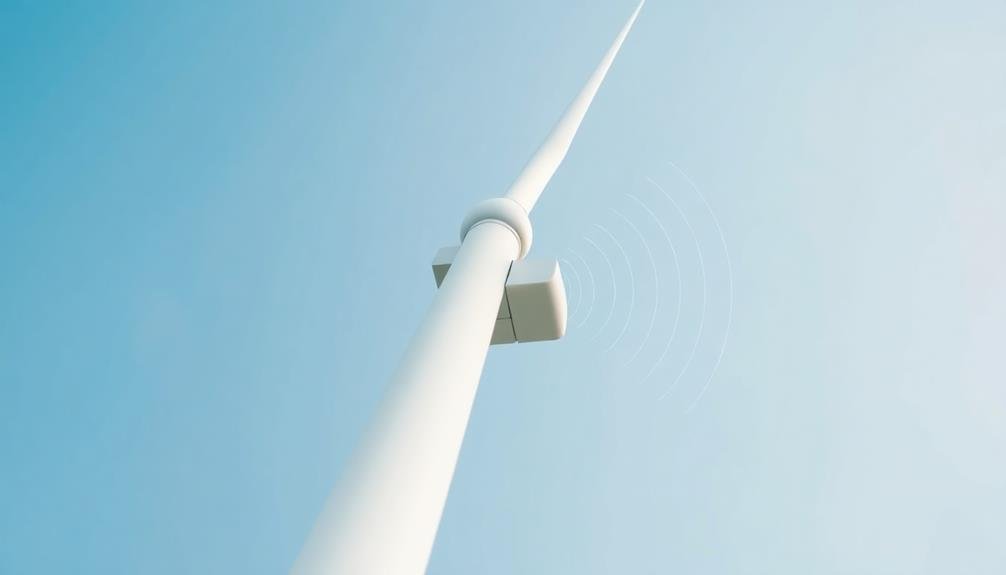
Two main types of wind turbines exist: horizontal axis and vertical axis.
Vertical axis wind turbines (VAWTs) are less common but offer unique advantages. You'll recognize them by their vertical rotor shaft and blades that spin perpendicular to the ground. Unlike their horizontal counterparts, VAWTs don't need to face the wind, making them ideal for areas with turbulent or changing wind directions.
VAWTs come in two primary designs: Darrieus and Savonius. The Darrieus type resembles an eggbeater, with curved blades attached to a central shaft. It's more efficient but requires a motor to start. The Savonius design uses S-shaped blades and can self-start in low winds.
You'll find VAWTs are generally quieter than horizontal axis turbines due to their lower tip speeds. They're also shorter, making them less visually intrusive and easier to maintain.
However, they're typically less efficient in large-scale power generation. VAWTs are best suited for urban environments, rooftops, and small-scale applications where noise reduction and adaptability to changing wind conditions are vital.
Sources of Turbine Noise
To understand how to reduce wind turbine noise, you'll need to recognize its two main sources.
Mechanical noise generation occurs from the turbine's moving parts, including the gearbox, generator, and yaw drive.
Aerodynamic sound sources, on the other hand, result from the interaction between the turbine blades and the air, producing various types of noise as the blades rotate.
Mechanical Noise Generation
Wind turbines generate noise from several mechanical sources, primarily within the nacelle. You'll find that the gearbox, generator, and cooling systems are the main culprits. The gearbox, responsible for increasing the rotational speed from the rotor to the generator, can produce a low-frequency hum or whine. The generator itself creates a high-pitched whine due to its rapid rotation and electromagnetic interactions. Cooling systems, including fans and pumps, contribute additional mechanical noise as they work to regulate temperature.
To better understand mechanical noise sources, consider these key points:
- Bearing wear and tear can increase noise levels over time
- Loose components or improper assembly may cause rattling or vibrations
- Insufficient lubrication can lead to increased friction and noise
- Imbalances in rotating parts can result in rhythmic sound patterns
You can reduce mechanical noise by implementing regular maintenance schedules, using high-quality components, and ensuring proper assembly and alignment.
Advanced technologies like direct-drive systems eliminate the need for gearboxes, potentially reducing overall mechanical noise. By addressing these mechanical noise sources, you'll greatly improve the acoustic performance of wind turbines, making them more acceptable to nearby communities.
Aerodynamic Sound Sources
Frequently overlooked, aerodynamic noise sources contribute greatly to the overall sound profile of wind turbines. You'll find that these sources are primarily associated with the interaction between the turbine blades and the surrounding air. As the blades rotate, they create various types of aerodynamic noise.
The most important aerodynamic sound source is turbulent boundary layer trailing edge noise. This occurs when turbulent air flow passes over the blade's trailing edge, creating a distinctive "swishing" sound.
You'll also encounter separation-stall noise, which happens when airflow separates from the blade surface at high angles of attack.
Another source is tip vortex formation noise, produced by the pressure difference between the upper and lower surfaces of the blade tip.
You'll notice vortex shedding noise too, caused by alternating low-pressure zones behind the blades.
Finally, there's inflow turbulence noise, generated when the blades encounter atmospheric turbulence.
Understanding these aerodynamic noise sources is essential for developing effective noise reduction strategies. By addressing each source individually, you can greatly lower the overall noise output of vertical axis wind turbines, making them more suitable for urban and residential applications.
Importance of Noise Reduction
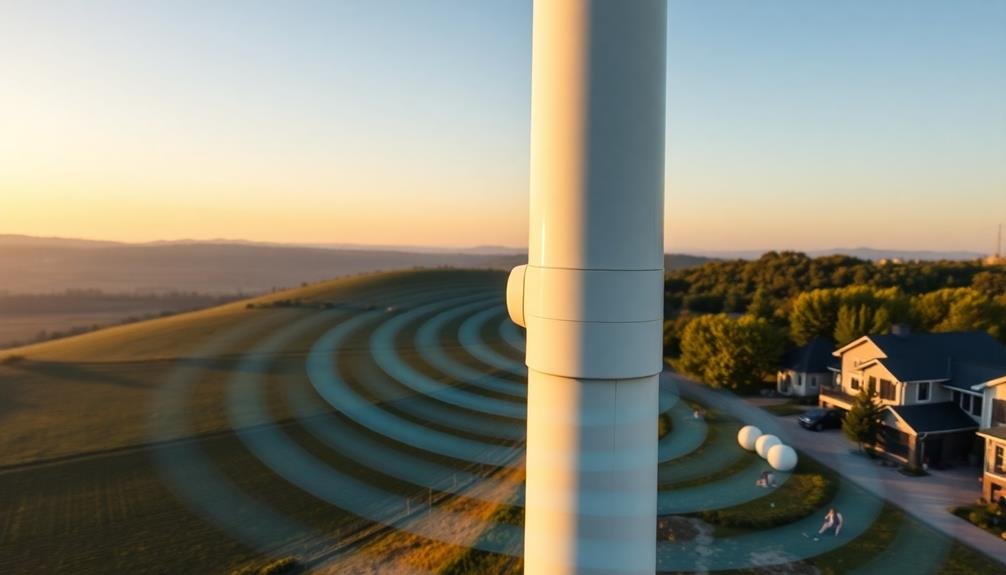
Reducing wind turbine noise is essential for minimizing environmental impact concerns.
You'll find that quieter turbines are less disruptive to local wildlife and ecosystems.
Additionally, addressing noise issues head-on can help overcome community acceptance challenges, making it easier to implement wind energy projects in populated areas.
Environmental Impact Concerns
Stretching across vast landscapes, wind turbines have become iconic symbols of renewable energy. However, their environmental impact extends beyond their visual presence. While they produce clean energy, the noise generated by these turbines can have significant consequences for both wildlife and nearby communities.
You'll find that noise pollution from wind turbines affects various aspects of the environment:
- Disrupts wildlife habitats and migration patterns
- Interferes with bird and bat echolocation systems
- Causes stress and behavioral changes in local fauna
- Impacts human health and quality of life in nearby areas
As you explore the environmental concerns surrounding wind turbine noise, you'll discover that it's not just about decibel levels. The low-frequency sounds and infrasound produced by turbines can travel long distances, potentially affecting ecosystems far from the source.
These sounds may disrupt breeding patterns, alter predator-prey relationships, and even influence plant growth.
You'll also notice that the impact on human communities can't be overlooked. Prolonged exposure to turbine noise may lead to sleep disturbances, anxiety, and other health issues.
Community Acceptance Challenges
The clamor of wind turbines doesn't just affect wildlife; it's a major hurdle for community acceptance of wind energy projects. You'll find that noise complaints are among the most common reasons for public opposition to wind farms.
People living near turbines often report sleep disturbances, headaches, and stress-related issues due to the constant low-frequency sound and vibrations.
To gain community support, you must prioritize noise reduction in wind turbine design and placement. You'll need to conduct thorough acoustic studies and implement noise mitigation strategies. These may include using advanced blade designs, optimizing turbine spacing, and installing sound-dampening technology.
You should also engage with local communities early in the planning process. By involving residents in decision-making and addressing their concerns, you'll build trust and increase the likelihood of project approval.
You might consider offering compensation or community benefits to those affected by turbine noise.
Aerodynamic Design Improvements
Aerodynamic design improvements offer several key strategies for minimizing wind turbine noise. You'll find that engineers are constantly refining blade shapes, tip designs, and overall turbine configurations to reduce acoustic emissions. These advancements not only decrease noise levels but also enhance energy production efficiency.
When exploring aerodynamic improvements, you should consider:
- Blade shape optimization
- Serrated trailing edges
- Vortex generators
- Low-noise airfoils
By focusing on blade shape optimization, you can greatly reduce turbulent air flow, which is a major source of noise. Serrated trailing edges, inspired by owl feathers, help break up air vortices and minimize sound production.
Vortex generators, small fins attached to the blades, can improve airflow and reduce stall-induced noise. Low-noise airfoils, designed with specialized curvatures, help maintain laminar flow and reduce turbulence.
You'll also find that some manufacturers are experimenting with flexible blade materials that can adapt to wind conditions, further reducing noise.
These innovations, combined with advanced computer modeling and wind tunnel testing, are pushing the boundaries of quiet wind turbine technology. As research continues, you can expect even more sophisticated aerodynamic solutions to emerge, making wind energy an increasingly attractive and community-friendly option.
Blade Material Selection

Material selection for wind turbine blades plays an essential role in noise reduction. When choosing blade materials, you'll want to take into account factors like density, stiffness, and acoustic properties. Lighter materials can reduce overall turbine weight, decreasing mechanical stress and associated noise. Stiffer materials help maintain blade shape under load, minimizing vibrations that contribute to noise.
Composite materials, such as fiberglass-reinforced plastics or carbon fiber, are popular choices due to their high strength-to-weight ratio and customizable properties. You can tailor these materials to absorb specific sound frequencies, further reducing noise output.
Some manufacturers are exploring innovative materials like bamboo or recycled plastics, which offer unique acoustic properties and sustainability benefits.
It's important to examine the blade's surface texture when selecting materials. Smoother surfaces generally produce less aerodynamic noise, but you'll need to balance this with other performance factors. Coatings or treatments can be applied to enhance noise reduction properties without compromising structural integrity.
Vibration Dampening Techniques
Vibrations are the silent culprits behind much of a wind turbine's noise output. To effectively reduce noise, you'll need to implement vibration dampening techniques. These methods work by absorbing and dissipating the energy that causes unwanted vibrations, resulting in quieter operation.
One of the most effective approaches is to use specialized materials designed to absorb vibrations. You can apply these materials to key components of the turbine, such as the blades, nacelle, and tower.
Additionally, you should consider implementing active damping systems that use sensors and actuators to counteract vibrations in real-time.
Here are some vibration dampening techniques you can employ:
- Install rubber or elastomeric mounts between the turbine and its support structure
- Use tuned mass dampers to absorb vibrations at specific frequencies
- Apply constrained layer damping treatments to blade surfaces
- Implement active vibration control systems with piezoelectric actuators
Gearbox and Generator Modifications
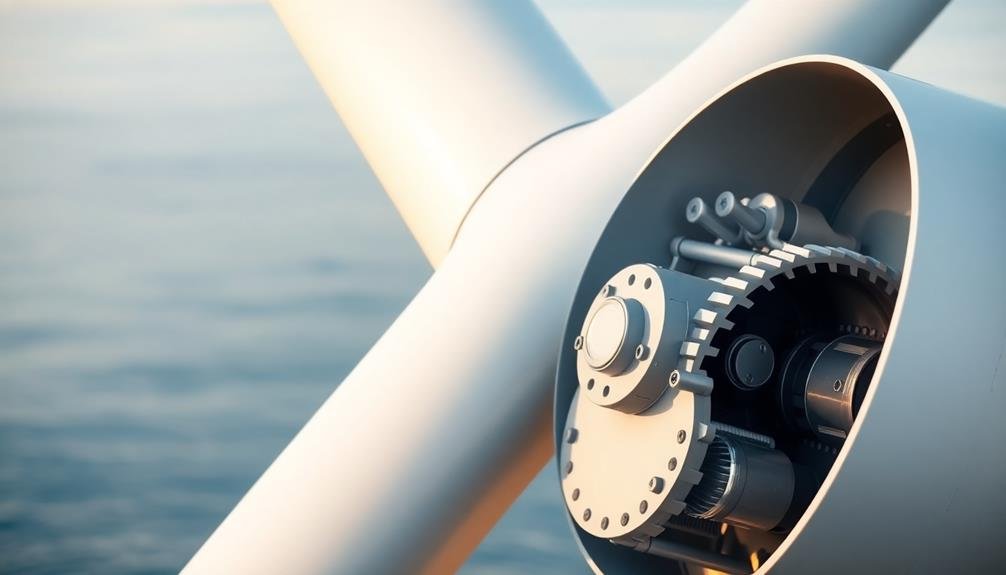
You'll find that gearbox and generator modifications play an essential role in reducing wind turbine noise.
Low-noise gearbox designs incorporate advanced tooth profiles and precision-machined components to minimize gear meshing noise.
Generator insulation techniques, such as acoustic enclosures and vibration isolation mounts, can notably dampen the electromagnetic noise produced during electricity generation.
Low-Noise Gearbox Designs
One of the primary sources of wind turbine noise comes from the gearbox and generator. To address this issue, engineers have developed low-noise gearbox designs specifically for wind turbines. These innovative designs aim to reduce mechanical noise while maintaining efficiency and reliability.
You'll find that low-noise gearboxes often incorporate several key features:
- Helical gears with refined tooth profiles
- Advanced lubricants to diminish friction
- Improved housing designs for better sound insulation
- Precision manufacturing techniques for tighter tolerances
By implementing these features, you can greatly reduce the noise produced by your wind turbine's gearbox. The helical gears distribute the load more evenly, minimizing vibrations and gear mesh noise. Advanced lubricants help reduce friction between moving parts, further decreasing mechanical noise.
You should also take into account the gearbox housing design. Improved housing materials and shapes can better contain and absorb sound waves, preventing them from escaping into the environment. Additionally, precision manufacturing techniques guarantee that all components fit together perfectly, reducing rattling and other unwanted noises.
When selecting a low-noise gearbox for your wind turbine, you'll want to take into account factors such as power rating, size constraints, and maintenance requirements to guarantee peak performance and noise reduction.
Generator Insulation Techniques
Generator insulation techniques play an essential role in reducing wind turbine noise. You'll find that these methods focus on minimizing vibrations and containing sound within the generator housing. By implementing effective insulation, you can considerably decrease the overall noise output of your wind turbine.
One of the primary techniques involves using acoustic enclosures. These specially designed casings surround the generator, absorbing and dampening sound waves. You'll want to choose materials with high sound absorption coefficients, such as polyurethane foam or fiberglass.
Here's a quick comparison of common generator insulation techniques:
| Technique | Noise Reduction | Cost |
|---|---|---|
| Acoustic Enclosures | High | Moderate |
| Vibration Dampers | Moderate | Low |
| Sound-Absorbing Coatings | Low | Low |
Another effective approach is the use of vibration dampers. These devices absorb mechanical energy, reducing the transmission of vibrations from the generator to other turbine components. You'll often see rubber mounts or spring systems employed for this purpose.
Lastly, don't overlook the importance of proper maintenance. Regular inspection and replacement of worn insulation materials will guarantee continued noise reduction effectiveness. By combining these techniques, you'll considerably decrease your wind turbine's noise output, making it more environmentally friendly and neighbor-friendly.
Optimal Placement for Noise Mitigation
When considering ideal placement for noise mitigation, strategic positioning of wind turbines plays an essential role. You'll need to carefully assess the surrounding landscape and nearby structures to minimize noise impact on residential areas. Consider prevailing wind directions and topographical features that might affect sound propagation.
To enhance turbine placement for noise reduction, you should:
- Maintain adequate distance from residential zones
- Utilize natural barriers like hills or tree lines
- Group turbines in clusters to centralize noise sources
- Align turbines perpendicular to prevailing winds
You'll want to conduct thorough noise modeling studies to predict sound levels at various locations. This will help you identify potential problem areas and adjust turbine positions accordingly.
Don't forget to account for low-frequency noise, which can travel further than higher frequencies.
It's vital to balance noise mitigation with energy production efficiency. You might need to compromise on ideal wind exposure to reduce noise impact.
Wind Speed and Noise Correlation
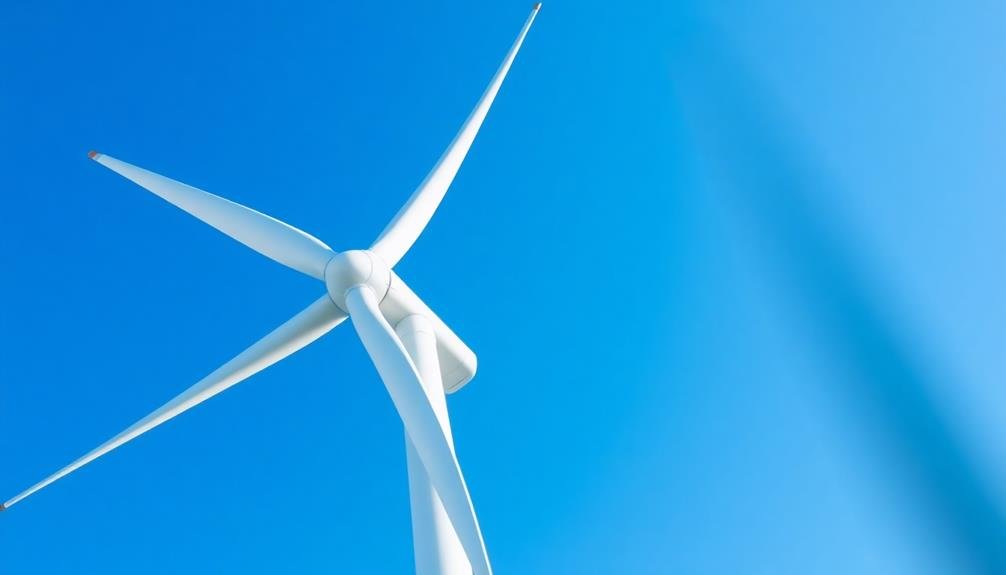
Beyond ideal placement, understanding the relationship between wind speed and turbine noise is essential for effective noise management.
You'll find that as wind speed increases, so does the noise generated by wind turbines. This correlation isn't linear, though. At low wind speeds, turbine noise is often masked by ambient sounds. As wind speeds rise, the noise becomes more noticeable, reaching a peak at moderate speeds.
You'll want to pay attention to the cut-in speed of your turbines. This is the wind speed at which they start generating power. Below this speed, the turbines produce minimal noise. Above it, you'll notice a rapid increase in sound levels. It's vital to take into account your local wind patterns when selecting turbines and planning their operation.
You can use this knowledge to implement adaptive control strategies. For instance, you might adjust blade pitch or rotor speed during high-wind conditions to reduce noise. Some turbines even have specific noise-reduction modes that can be activated when needed.
Maintenance for Quieter Operation
Regular upkeep plays an essential role in keeping wind turbines running quietly. You'll need to implement a thorough maintenance schedule to guarantee your turbines operate at their best. This includes routine inspections, lubrication of moving parts, and timely replacement of worn components. By addressing potential issues before they escalate, you'll prevent excessive noise caused by mechanical problems.
Pay close attention to the following areas during maintenance:
- Bearings: Regularly lubricate and replace when necessary to reduce friction and vibration.
- Blades: Inspect for damage, clean, and repair any cracks or chips to maintain aerodynamic efficiency.
- Gearbox: Check oil levels, change filters, and monitor for unusual sounds or vibrations.
- Bolts and fasteners: Tighten loose connections to prevent rattling and guarantee structural integrity.
Don't forget to keep detailed records of all maintenance activities. This will help you identify patterns and anticipate potential problems.
You should also stay up-to-date with the latest noise reduction technologies and consider upgrading components when more efficient options become available. By prioritizing maintenance, you'll not only reduce noise but also extend the lifespan of your wind turbines and improve their overall performance.
Acoustic Barriers and Enclosures

Numerous wind farm operators are turning to acoustic barriers and enclosures as effective solutions for noise reduction. These structures can notably diminish the sound emissions from vertical axis wind turbines, making them more acceptable to nearby communities.
You'll find that acoustic barriers come in various forms, including walls, fences, and earthen berms. They work by blocking the direct path of sound waves, reducing noise levels on the other side.
When designing barriers, you'll need to evaluate factors like height, length, and material composition to enhance their effectiveness.
Enclosures, on the other hand, completely surround the turbine, offering even greater noise reduction. You can choose from options like full or partial enclosures, depending on your specific needs and site constraints.
These structures not only dampen sound but can also protect the turbine from harsh weather conditions.
When implementing barriers or enclosures, you'll need to balance noise reduction with other factors like cost, visual impact, and potential effects on turbine performance.
It's essential to work with acoustic engineers to develop customized solutions that meet your specific requirements while ensuring ideal turbine operation.
Regulatory Standards for Turbine Noise
While acoustic barriers and enclosures can remarkably reduce wind turbine noise, they're just one part of the equation.
Regulatory standards play an essential role in ensuring wind turbines operate within acceptable noise limits. You'll find that many countries and regions have established specific guidelines for turbine noise emissions.
These standards typically set maximum allowable sound levels at nearby residences, often measured in decibels (dB). They may vary depending on the time of day, with stricter limits during nighttime hours.
You'll need to familiarize yourself with local regulations, as they can greatly impact turbine design and placement.
Here are key aspects of regulatory standards for turbine noise:
- Maximum sound pressure levels at property boundaries
- Tonal and low-frequency noise limits
- Measurement methods and procedures
- Compliance monitoring requirements
Community Engagement and Acceptance

Community engagement and acceptance are crucial components in the successful implementation of wind turbine projects. You'll need to involve local residents early in the planning process to address their concerns and build trust.
Start by organizing informational meetings where you can explain the benefits of wind energy and the steps you're taking to minimize noise pollution. Be transparent about potential impacts and mitigation strategies.
You should establish open communication channels, such as dedicated hotlines or online platforms, where community members can voice their concerns or ask questions.
Consider forming a community advisory board to promote ongoing dialogue and collaboration.
To increase acceptance, you might offer community benefits like reduced electricity rates, local job opportunities, or investments in community projects.
You can also arrange site visits to operational wind farms, allowing residents to experience turbine noise levels firsthand.
Remember to adapt your engagement strategies to suit local cultural norms and preferences.
Frequently Asked Questions
How Do Vertical Axis Wind Turbines Compare to Horizontal Axis Turbines in Energy Output?
You'll find that horizontal axis turbines generally produce more energy than vertical axis ones. They're more efficient in converting wind to power, especially at higher wind speeds. However, vertical axis turbines have advantages in certain situations.
What Is the Average Lifespan of a Vertical Axis Wind Turbine?
You'll find that vertical axis wind turbines typically last 20-25 years. However, their lifespan can vary based on maintenance, environmental conditions, and quality of materials. Regular upkeep can extend their operational life considerably.
Can Vertical Axis Wind Turbines Be Installed on Residential Rooftops?
Yes, you can install vertical axis wind turbines on residential rooftops. They're compact and work well in urban areas. You'll need to take into account local regulations, structural support, and potential noise issues before installation. They're a great renewable energy option.
Are There Any Bird-Friendly Designs for Vertical Axis Wind Turbines?
You'll find some bird-friendly vertical axis wind turbine designs. They often feature slower rotation speeds, visible blades, and enclosed structures. These modifications help birds detect and avoid the turbines, reducing collision risks in your area.
How Do Extreme Weather Conditions Affect the Performance of Vertical Axis Wind Turbines?
You'll find that extreme weather impacts vertical axis wind turbines considerably. High winds can overload them, while icing reduces efficiency. Heavy rain or snow may cause imbalances. However, they're generally more resilient to turbulent winds than horizontal turbines.
In Summary
You've explored various strategies to reduce noise from vertical axis wind turbines. By improving aerodynamic design, choosing the right materials, and maintaining your turbines well, you'll greatly decrease noise pollution. Don't forget to take into account acoustic barriers and stay up-to-date with regulations. Most importantly, engage with your community to foster acceptance. With these approaches, you're well-equipped to make your turbines quieter and more neighbor-friendly.

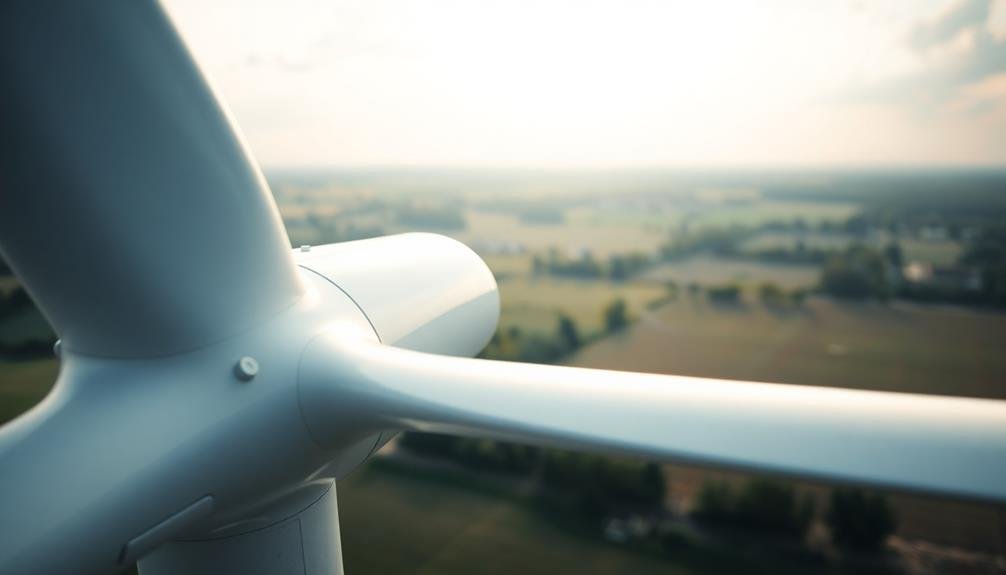

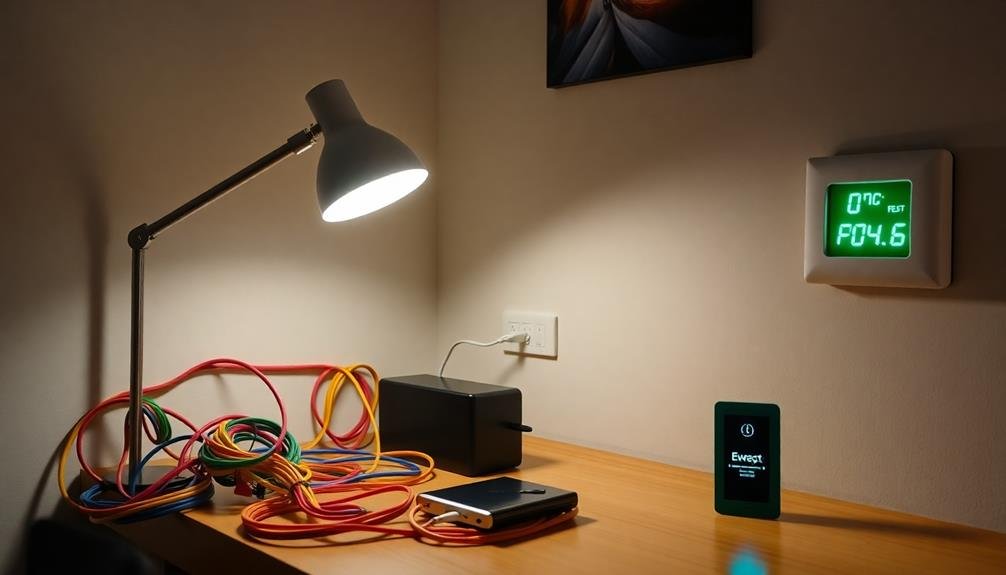

Leave a Reply